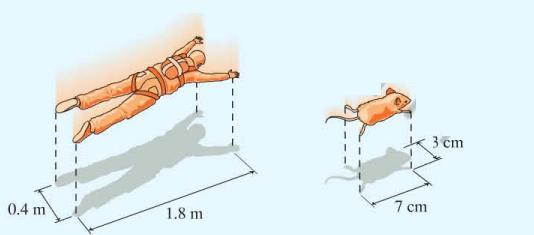The fastest recorded skydive was by an Air Force officer who jumped from a helium balloon at
Question:
The fastest recorded skydive was by an Air Force officer who jumped from a helium balloon at an elevation of 103,000 ft, three times higher than airliners fly. Because the density of air is so low at these altitudes, he reached a speed of 614 mph at an elevation of 90,000 ft, then gradually slowed as the air became more dense. Assume that he fell in the spread-eagle position of Example 5.15 and that his low- altitude terminal speed is 125 mph. Use this information to determine the density of air at 90,000 ft.
Example 5.15
A skydiver and his pet mouse jump from a plane. Estimate their terminal speeds. To use Equation 5.16 we need to estimate the mass m and cross-section area A of both man and mouse. FIGURE 5.28 shows how. A typical skydiver might be 1.8 m long and 0.4 m wide (A = 0.72 m) with a mass of 75 kg, while a mouse has a mass of perhaps 20 g (0.020 kg) and is 7 cm long and 3 cm wide (A = 0.07 m X 0.03 m = 0.0021 m2).
Equation 5.16

FIGURE 5.28

Step by Step Answer:

College Physics A Strategic Approach
ISBN: 9780321595492
2nd Edition
Authors: Randall D. Knight, Brian Jones, Stuart Field





